M. Isidora Forrest's Blog, page 20
February 20, 2022
The Knife of Isis
During these last few years, there have been far too many things cut out of our lives. I miss my people.
On the other hand, this time has also given many of us the opportunity to discard things that desperately need to be cut out and left behind. This is a time of change and we have choices to make. And there is a tool that Our Lady Isis offers to us to assist in the powerful magic of making these decisions. It is a tool that has often symbolized discernment. It is Her knife.
Isis gives you this knife of Hers which She gave to Horus after the mourning of the Gods.
Coffin Texts, Formula 102
What is this mysterious knife of Isis? Let’s see what we can find out…
 The des, the ancient Egyptian flint knife
The des, the ancient Egyptian flint knifeIn ancient Egypt, the knife was not only a practical tool and weapon; it was also a magical tool and weapon. The preferred ritual knife was the ancient flint knife, called des. Des actually means “flint,” but it remained the general word used for knife throughout Egyptian history. As you might expect, knives, practical and magical, could be used both defensively and offensively.
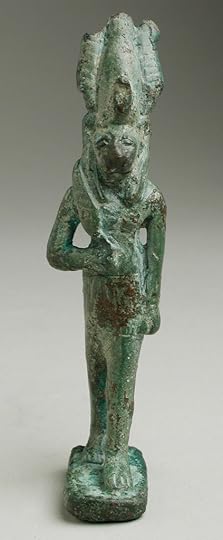 The Lion God Maahes with a des
The Lion God Maahes with a desKnives appear frequently in representations of the Egyptian otherworld. They are used in slaying the enemies of the deceased and smoothing the passage through the land of the dead. Some magical rites called for a protective circle of knives to be erected for the working. (Wouldn’t that be a scary/powerful casting for an aggressive ritual? I feel the hairs rise on the back of my neck thinking about it.)
Knives are also found in judgment scenes where the deceased must be found worthy or fall to the knives of Divine figures with names like Slaughterer and Repulser of the Wicked. In general Egyptian idiom, someone who was suffering in any way was one who was “under the knife.”
Harmful beings, such as Re’s great enemy, the giant serpent Apophis, and Set, the enemy of Isis and Horus, are often shown stabbed repeatedly with magical knives to subdue and render them harmless. Even the hieroglyphs of Set’s name were sometimes shown stabbed with knives. Knives were also used to decapitate otherworldly enemies. In some scenes, rows of bound and decapitated “enemies of Re” or “enemies of Horus” are guarded by knife-wielding Goddesses and Gods. Decapitation by knife seems to have been a particular threat to the deceased as well—and Isis is called upon to “make firm the head” of the deceased upon their neck.
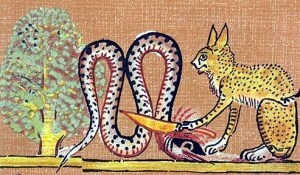 The Egyptian solar Great Cat decapitating the enemy snake Apophis with a flint knife
The Egyptian solar Great Cat decapitating the enemy snake Apophis with a flint knifeIn Egyptian thought, knives have both solar and lunar symbolism. The twin sycamore fig trees between which the Sun God Re rose each day were sometimes called the Two Knives (perhaps from the similarity between the shape of the knife and the hieroglyph for “tree”). And the crescent moon was considered to be a knife wielded by the God of the Moon, Thoth or I’ah.
In the Book of the Amduat, Isis and Set work together to subdue the enemy snake, Apophis, using both magic and knives. Apophis is shown stabbed with knives, bespelled by Isis, and bound by Serket and Set while four Goddesses with knives wait to dismember the serpent. The corpse of Re, awaiting rebirth in the Sun barque, is also guarded by knives.
 Apophis subdued by knives
Apophis subdued by knivesIn yet another myth, Isis transforms Herself into a hound with a knife at the end of its tail in order to engage in a shapeshifting battle with Set. As Isis the Avenger, the Goddess is said to have a knife-shaped phallus (eeeshh!). And in the Book of the Dead, Isis owns a sacred knife that the deceased must know by name in the otherworld. Oddly, it is part of the deceased’s fishing equipment and is said to be the knife with which Isis cut the birth cord of Horus.
As a Great Goddess, Isis’ knife has all these powers. It offers magical protection and defense, as when She uses knives and Her own magical power to protect the Sun God during His otherworld journey, and practical uses, as when She uses it to cut the birth cord of Horus, which is also the re-birth cord of the deceased.
 Tutankhamon’s beautiful ritual knife
Tutankhamon’s beautiful ritual knifeWhen Isis gives “this knife of Hers” to Horus “after the mourning of the Gods,” the Goddess is giving Her son power and strength following the mournful death of His father, Osiris. By receiving it, the deceased, too, accepts a tool imbued with Isis’ considerable power following their own death—and inevitable rebirth beneath the protecting wings of Isis.
Although I did not suggest a knife as one of the ritual tools of Isis in Isis Magic, those who enjoy sharp objects may enjoy acquiring a ritual knife for Isis and charging it with Her protection and strength.
I once had a vision of a fierce Isis in which each of the feathers in Her wide-spread wings was a blade. It was fearsome, powerful, and…weirdly comforting…
 Look at this recently found beauty—a rock crystal knife blade; 3000 BCE found in Spain
Look at this recently found beauty—a rock crystal knife blade; 3000 BCE found in Spain
February 13, 2022
Becoming the Uraeus
 Uraeus-Ouraios-Iaret
Uraeus-Ouraios-IaretI breathe. Slowly. Deeply. Trying to shake off the work day.
Ritual helps, calming and focusing me. I purify the temple, I purify myself, with the pure water from the Well of Nephthys. I consecrate the temple, I consecrate myself, with the pure Flame from the Mouth of Nephthys. By Her magic, by Her grace, the temple and I are purified and consecrated.
I breathe and wait.
When I am ready, I Establish the Horizons: east, west, south, north. The Horizons, the Akhet—the Light Land—endures forever. With my serpentform wands, “Neheh” and “Djet,” I trace the boundaries, the limits, of Her temple. I am becoming focused and relaxed now. I breathe in. I breathe out. As I step through the Gateway I ask, “Let me enter Your temple, O Great Goddess Nephthys.” She allows me to cross the threshold into Her twilight garden once more.
 A beautiful fantasy temple
A beautiful fantasy templeHaving used this rite a number of times now, it is beginning to flow a bit better and I believe it will continue to do so as I begin to memorize it. (Always learn the ritual, if possible. It frees the mind…as well as creativity and inspiration. A ritual script is not a prison, but rather a scaffolding upon which to build our connection with the Divine.)
 Nephthys by the Popovy Sisters. She doesn’t seem to be on their site now, though…
Nephthys by the Popovy Sisters. She doesn’t seem to be on their site now, though…Now, I raise my hands in the graceful Nebet gesture as I invoke Her, the Beautiful Sister, ta Senet Noferet.
Soon, She is present, but less emphatically than Her last Arrival. This time, I mostly hear-sense-intuit Her voice surrounding me. Yet I also know that Her Form is seated casually in the eastern part of the temple. I feel Her vibration in my body as She speaks in my mind.
“What should I know of You now?” I ask.
“I am come to break you free,” She says. And I understand immediately what She means because She is in my head and I am in Her heart.
“You will take on Forms, Kheperu” She says, changing the subject abruptly. “First, the Uraeus.”
 I am a serpent of lapis lazuli and gold
I am a serpent of lapis lazuli and goldAnd I am one long spine. She has turned me so fast that my mind has not had a chance to catch up with the magic that She has worked upon my ka (I think it is my ka She has changed). I try to feel my scales and the little flicking of the tip of my tail, which is not a tail at all, but my whole body. “Sink into the earth and feel Him (She means the Earth God Geb) rumbling, living,” She says. I lie on my back on the floor of my temple, Her temple. Now suddenly, I am rushing, fast, fast across the ground over sand, grasses, mud. “Where am I rushing, Goddess?” I think to Her. “Home,” She says.
“Now, rise up,” the Goddess instructs. I do. My serpent body is coiled in a figure eight beneath me, which works quite well with my human body sitting cross-legged on the floor. (Uraeus is the latinized form of the Greek ouraios, which comes from ancient Egyptian iaret, meaning “she who rises up,” by the way. And it is a feminine word. The cobra hieroglyph was often used as a determinative for Goddesses.) I run energy through the figure eight and up to my hooded head with its wide mouth.
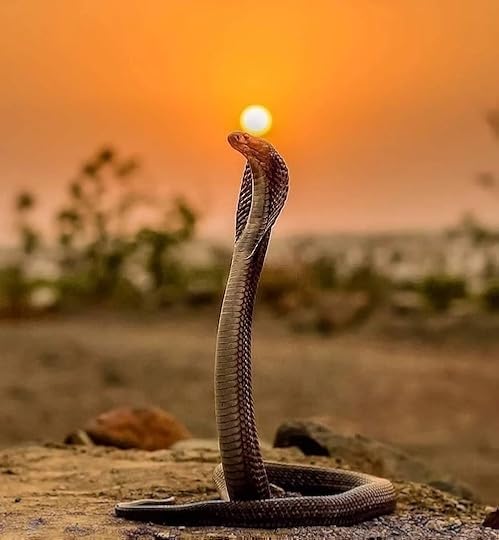 She Who Rises Up
She Who Rises UpI am a serpent of gold and lapis lazuli. My eyes are turquoise. My hood is spread and I sway side-to-side, watching. I see more this way. I feel the rhythms of Father Geb beneath me. It is late winter here and He shudders and stretches. I sense His great, green phallus rising, even as I have risen. I am strong, strong. I can balance my entire body upright with just a tail tip for anchor.
Since Nephthys had been so insistent upon my serpent self being in harmony with the earth and Geb, after the vision, I decided to look Him up a bit as I had never studied much about Him. The very first thing that Google throws my way is that He is often considered the Father of Snakes. I had never heard this before. (And that is how these things often work.) Now I understand Her insistence. In the Coffin Texts, Geb is specifically the father of the powerful, primordial snake Nehebkau (“He Who Yokes the Kas”) and one name for a serpent in general is sa-ta, “son of earth.”
 Geb by Jeszika Le Vye. Note His snakes
Geb by Jeszika Le Vye. Note His snakes“What have you eaten?” asks the Goddess, bringing my attention back to the vision. “I live on Magic,” I tell Her easily. “I am the red and the blue currents entwined, which is Hathor, Who is Nephthys.” “Yes. Now you see,” She says. “I am the Last One (She means She is the last-born of the Children of Nuet and Geb) and all Their powers exist in Me; like the element of Earth.” (Again, She is using the stuff in my head to teach me things. This connects to some other symbolism in my own magical training, but in a different system. What’s more, I learn after the fact, that in the Coffin Texts, the deceased, as the serpent Nehebkau, is told “there is no God Who has not His ka in You.” Thus, just as the power of the entire Ennead resides in Nephthys, so does the ka-power of all the Deities reside in the serpent son of Geb.)
But for now, I am still a uraeus serpent, risen up from my lapis lazuli coils. I breathe up the power from the Living Earth, draw it through each coil of my body, and breathe it out my mouth as fire. It does not burn me; it feels cool coming up from the earth. In the next moment, the temple is on fire and I dance a snake dance in the unburning flames. “Why is the world on fire, Goddess?” I ask.
 Breathing Fire
Breathing Fire“This is power. Take in the ka of Fire,” She says. In Her name, I ask Fire’s permission and, being granted it, I breathe in the fiery ka-power, circulating it in a figure eight/infinity symbol through my coiled body. Will I be part uraeus from now on I wonder? I roll out of my figure eight and onto my belly on the floor of the temple. I can feel His great, green phallus poking, rather playfully, at my stomach. It’s funny and it makes me laugh.
“What have you learned, Little Sister?” the Goddess asks. “Why and how You are the Uraeus and a clue about the nature of Your power. To know my own strength. To remember Geb and He will increase my power. To dance with His rhythm. To take in the ka of Fire,” I answer. I wonder if that’s enough. I wonder if I got the lesson right. She neither confirms nor denies.
 Cobra scales up close
Cobra scales up close“You must connect with My Beasts,” She declares, ending our session. “Come back next time and we will do another.” Hmm, I do believe I am being King Arthur-ed.
I stand. The serpent scales fall from my human body and my breath is, once more, simply air. (But my blood just might be infused with a bit of Divine Fire.) I thank Nephthys for Her presence and Her counsel. I acknowledge the Horizons, east, west, south, north. With Neheh and Djet, I take down the limits of Her temple that I have traced. They endure forever nonetheless. Everything flows back into the heart-breakingly beautiful brilliance of the Akhet.
I sit down again and breathe slowly and deeply.
 Adoring the uraei
Adoring the uraei
February 6, 2022
Isis, Lady of Light
 She shines
She shinesShe is come.
The Goddess arises and Light flows into the world. Once again.
While I know some of us are buried in snow right now (especially those of us in the northern hemisphere), even that increases the light. The sparkling brilliance of snow reflects the light of sun or moon, illuminating the land by day and by night. Yes, it is cold now. But the light is returning. I breathe in and I breathe the enlivening Light of Isis. I breathe in Her cool, wintry breath.
Perhaps you, as I, have been lighting more candles and lamps lately—whether as a simple boost to the spirit or to catch a ride on the great magical tide of the Light’s Return. If so, we will not be out of step with ancient Egyptian practices.
 Offering tekau in a tomb
Offering tekau in a tombIn a world without electricity, light—especially in dark times and places—was exceptionally valuable. Something as simple as an ancient candle was quite an investment. The fuel—fat and oil—was expensive. So was linen, the material often used for wicks. We know that the workman’s village at Deir el Medina would receive shipments of old clothes and fat to make the torches they needed to work in the tombs. What’s more, the making of them had to be done under supervision so that none of the precious fat went missing.
The most common Egyptian term for these types of lamps or torches was “teka (sing.)” or “tekau (pl.).” A version of the word survives today in Coptic as tik or took, meaning “to spark” or “to kindle.” Tekau were given as offerings to the dead and to Deities. In fact, it may be that the offering of a teka to a Deity was the bare minimum that could be considered a proper temple offering.
Thus lighting a lamp or candle for Our Lady Isis is a most, most appropriate offering. Two is even better as tekau were often given in pairs. And if you’d like to offer Her tekau in the ancient color scheme, go red and white. Most paintings of tekau show them as a candy cane-like twist of red and white. This is because a teka was often made from a core of red (or white) linen, spiral-wrapped tight with white (or red) linen, then soaked in the fat or oil. They could be put on a stick like a torch and carried by hand, placed in a bowl of sand (?), or placed in a standing brazier. There was another product called medjet, which may have been the fat dyed red then used to make tekau or burned in a lamp.
 The West (usually the Goddess Amentet) offering bowls of tekau in a tomb
The West (usually the Goddess Amentet) offering bowls of tekau in a tombEgypt was particularly known for its Rites of Illumination that featured the lighting of tekau. We have a graffito from a Middle Kingdom workman’s village by a man named Sobekemhat that says as a child he was like a particular flowering plant, like “the ones put to the nose on the day of lighting teka by all the people.” So a festival of flowers and flame. I love this very much.
 Lighting the tekau
Lighting the tekauWe know that teka were lit for the blessed dead on the epagomenal birthdays of Osiris, Horus, Set, Isis & Nephthys, as well as on New Year’s Eve (which would have been Nephthys’ birthday), New Year’s Day, and during the Beautiful Festival of the Valley, in addition to other local festivals and significant occasions. Some scholars think that the New Year’s lighting of tekau may have been a Lower Egyptian ritual that gradually moved south to Upper Egypt. An ancient text tells us that on New Year’s Day, “…the house is given to its lord after kindling a teka in the temple.” So lighting a new fire, a teka, in the temple on New Year’s Day renewed and refreshed the temple for its Deity.
If the worship of Isis also first developed in Lower Egypt, as some researchers think, then lighting teka for Her—perhaps especially on Her birthday and the New Year—would have been an early rite for Her. (Come to think of it, we still light tiny tekau, placing them on birthday cakes to honor the years of a person’s life.) We have several surviving texts that refer to the teka being given for the ka of the Deity being offered to. It may be that the enlivening, illuminating, and renewing power of the teka was particularly effective in providing those benefits to the Deity’s vital essence or ka.
 Nephthys and Isis, in kiteform, stand behind Deities offering tekau in bowls.
Nephthys and Isis, in kiteform, stand behind Deities offering tekau in bowls.The tekau have the symbolism you might expect: illuminating the darkness for the dead until they are revitalized, “glorifying” the dead, and—like the fiery breath of Isis and Nephthys—protecting the dead as well as the Deities. In addition, as we just saw, they could also provide ritual renewal at the New Year. They may also have been part of the rite of the Reversion of Offerings. (Not quite sure how they were used there. I’m still tracking that down. I’ll let you know what I find out.)
 A homemade teka (not by me) showing the bend of the wick; in Egyptian paintings, the wick always bends toward the one being offered to.
A homemade teka (not by me) showing the bend of the wick; in Egyptian paintings, the wick always bends toward the one being offered to.A festival calendar from the temple of Edfu records a summer procession of Isis the Brilliant. During that festival, the image of the radiant Goddess was carried among the people in Her sacred boat, coming to rest in Her boat-sanctuary. There, the calendar text tells us “every kind of good thing is offered to Her.” Some modern Kemetic Orthodox groups celebrate this as the Aset Luminous Festival. Participants illuminate paper boats with candles and set them adrift to carry worshippers’ prayers to Isis. In accordance with the ancient traditions, offerings are also given to Isis at this time.
Now, you may be wondering how to deal with your tekau once they have been offered. Happily, we actually know this. Usually, they were extinguished in a bowl of milk, the milk of the Goddess. Today, this will be easier with a taper candle, but we might also be able to wet our fingers with milk, then pinch out the flame between our Goddess-blessed thumb and forefinger. In a large community ritual (back in the day when we could do that), we put out our ritual torches in bowls of milk. It was strangely powerful. I do recommend it.
 An oil lamp from Egypt, Roman period. It shows Isis and Harpocrates.
An oil lamp from Egypt, Roman period. It shows Isis and Harpocrates.The tradition of illumination for Isis continued even as Her worship crossed national boundaries. In his ancient novel, The Golden Ass, Apuleius describes the lanterns, torches, candles, and “other kinds of artificial light” that were carried in a procession for Isis in Cenchreae, Greece. Indeed, Apuleius notes that the processional lights were symbols of the heavenly light of the stars in the Goddess’ heaven. He also uses many allusions to light and radiance in telling his readers about Isis. For example, the blessings brought by Isis are described as “radiant” (inlustre). The initiating priest in Apuleius’ story says that, unlike blind Fortune, Isis sees and “illumines the other gods too with the radiance of Her light.”
At this time and in this place, perhaps you will join with me in lighting tekau for Isis, for Nephthys, and for all your Divine Ones, as we breathe in the growing light of the year.
Breathe in the Light of Isis, Lady of Light. Let it fill you, renew you, as Life arises. Once again.
 An image from the TV show Smallville, when Isis possesses Lois. To me it looks like the Goddess shining Her light on Her priestess.
An image from the TV show Smallville, when Isis possesses Lois. To me it looks like the Goddess shining Her light on Her priestess.
January 30, 2022
My Mother, My Heart
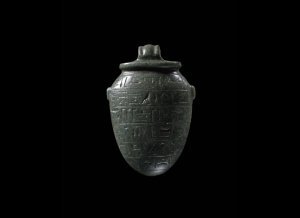 A heart amulet inscribed with magical text
A heart amulet inscribed with magical textThis is an update to a previous post. Nephthys will come back. But in the meantime, know that “we are alive in our hearts, we are wise in our hearts, we are One in our hearts…”
When we say we are “thinking with our hearts,” we mean that we are being led by our emotions rather than our rational minds. The ancient Egyptians would have thought that we had it only partly right. They knew that they thought with their hearts all the time; it was, after all, the organ of thought. In the myth of Isis and Re, Isis was said to have pondered “in Her heart” how She could become more powerful and to have decided “in Her heart” how to do so. Of course, the heart was also the seat of emotions, but most importantly, it was the center of life itself. The heart was so important to the wholeness of the individual that it was the only organ not removed during mummification.
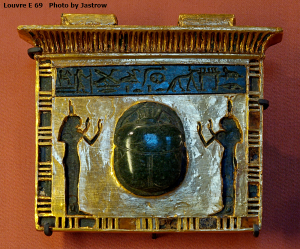 Isis and Nephthys guard the heart scarab that is given to the deceased.
Isis and Nephthys guard the heart scarab that is given to the deceased.There are two main Egyptian words for “heart,” ib and hati. As it turns out, the relationship between ib and hati is much debated in Egyptological circles. Early in the history of Egyptology, the two terms were considered synonyms and both related to the physical heart. In the 1930s, Alexandre Piankoff argued that hati was the physical heart, while ib was the metaphorical one and described the emotions. Many examples exist that seem to go along with this idea.
For instance, having great fear could be described as “the heart not being in the body.” Being happy was “broadness of heart.” “To wash the heart” was to relieve oneself of an emotion, either positive or negative. Friends “entered into each other’s hearts.” “To immerse the heart” was to hide one’s thoughts. Yet not all examples of the use of ib are quite that clear. We sometimes find ib as a seemingly physical thing and we sometimes find hati as a seemingly metaphorical thing.
 A heart scarab with magical text on the back
A heart scarab with magical text on the backIn the Coffin Texts, the ib (as well as the belly) is a container for magic. Coffin Text 657 instructs the heart to “remember what is in you,” that is, magic. Other texts refer to “magic, which my ib sends out” or command magic to “come to this, my ib.” Knowledge also resides in the ib. In a more metaphorical vein, the hati can be “set against” someone. And in Coffin Text 75, the deceased says “Your hearts (hati) have spoken to me, You Gods.” A number of the texts, known as “heart spells,” often have the two terms in parallel:
There will be given to you your heart (ib) which you had from your mother, your heart (hati) which belongs to your body, your soul which was upon the earth, your corpse which was upon the ground.
Coffin Texts, 20
So while usage isn’t always consistent, in this text and (I think) the majority of others, the “heart which you had from your mother” and “your heart which belongs to your body” are intangible and tangible concepts in the same way that the soul is intangible and corpse is tangible. But because both the ib and the hati will be given to the deceased, it is the totality of the heart, in both physical and spiritual aspects, that is required in the otherworld; both will be needed for rebirth.
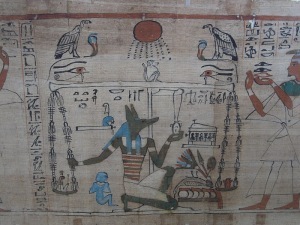 On one side of the balance, the heart, on the other the Feather of Truth; note the chains made of the Knot of Isis and the Djed of Osiris that uphold the pans of the balance. The deceased appears as a child and the Birth Goddess Meskhenet, in the form of a birthing brick, awaits the outcome.
On one side of the balance, the heart, on the other the Feather of Truth; note the chains made of the Knot of Isis and the Djed of Osiris that uphold the pans of the balance. The deceased appears as a child and the Birth Goddess Meskhenet, in the form of a birthing brick, awaits the outcome.Isis and Her sister Nephthys are among the foremost givers of hearts in these funerary texts. In the Pyramid Texts, Isis says, “I am Isis; I have come that I may lay hold of you and give you your heart for your body.” In the Coffin Texts, Isis and Horus reciprocally bring Their hearts to each other—and will do the same for the dead: “I bring for you your heart into your body even as Horus brought the heart of his mother, even as Isis brought the heart of her son Horus.” A similar passage comes from the daily rites of the temple of Amun Re. Isis is said to bring Horus His heart to “set its upon its seat.” Then Horus brings Isis Her heart to set it upon its seat. There was an Egyptian idiom, iset ib, that may shed some light. It literally means, “seat of the heart” and is equivalent to our “having set one’s heart upon” something. The iset ib is the heart’s desire. Were Isis and Horus giving each other Their heart’s desire?
 Anubis weighs the heart, ib and hati together, against the Feather of Truth
Anubis weighs the heart, ib and hati together, against the Feather of TruthYet for Isis devotees, there is another interpretation of iset ib that I think is even more beautiful. In this case, the iset ib would be the Iset Ib: the “Isis Heart.” The Iset Ib is that inner core where our individual hearts touch the heart of the Great Goddess Isis. The Isis Heart is the intangible, spiritual “heart that I had from my Mother,” in this case, our Great Mother Isis. It is that piece of the Goddess that lives within all of us and through which we can access Her greater Divine Heart and Being.
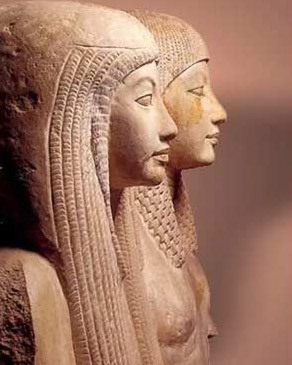 I am aware in my heart, the heart that I had from my Mother Isis
I am aware in my heart, the heart that I had from my Mother IsisJust as the ancient Egyptian dead needed their hearts, ib and hati, to be reborn, we, too, need our hati heart of our bodies to live and our ib heart to commune with the Divine. The Iset Ib is the ‘heart that I had from my Mother Isis’ and through it, we can discover Her at any time.
We become still, we breathe, and we focus on our hati heart, the living muscle in our body, which is the physical heart, but also seems to have been much more to the ancient Egyptians. As we relax and open the hati heart, we also open our ib heart. The physical becomes a gateway to the metaphysical. One heart opens another heart to commune with a Divine Heart. Isis speaks to both our hati and our ib hearts. And then She awakens our Iset Ib, our own Isis Heart, and we become “aware in my heart,” just as the Book of Coming Forth by Day says.
__ATA.cmd.push(function() { __ATA.initDynamicSlot({ id: 'atatags-26942-61f715283cdfb', location: 120, formFactor: '001', label: { text: 'Advertisements', }, creative: { reportAd: { text: 'Report this ad', }, privacySettings: { text: 'Privacy', } } }); });January 23, 2022
Scorpion Goddesses, Birth Goddesses
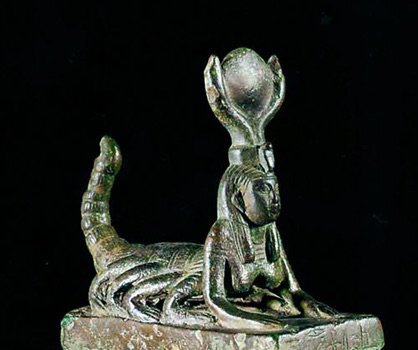 Isis the Scorpion
Isis the ScorpionI think this is the last installment about Scorpion Goddesses, at least for now…
You may recall from last time that the Scorpion Wives of Horus were sometimes invoked during childbirth. You may also remember that one of the types of bloodshed associated with Them is “the first blood of childbirth.” And that further, They may be connected to the Seven Hathors, Who are clearly Ladies of Love and its frequent result, children—for They are the Goddesses Who arrive to foretell the fate of newborns (most especially royal ones).
Here’s an example of a spell where all our Goddesses come together. This rite is to assist a woman in the throes of childbirth who is experiencing a difficult birth. Here, the physician/magician takes on the Godform of Horus to call upon His Scorpion Wife, Sepertunenes, as well as Nekhbet, the Vulture Mother Goddess, and a prehistoric Serpent Goddess named Wenut or Unut. Finally, Hathor is invoked to give the birthing mother health:
Come down, placenta! Come down, placenta, come down! I am Horus the Conjurer! And the one who is giving birth is [already] better than she was, as if she were delivered. O Sepertuenes, wife of Horus, O Nekhbet the Nubian One and the Eastern One, Wenut, Lady of Wenu [Hermopolis]! Come, please, act for the one who is in Your power! See, Hathor will place Her hand on her as an amulet of health. I am Horus Who saves her!
Borghouts, spell 61, my capitalization
So, here we have Horus calling one of His Scorpion Wives, the great Vulture Goddess of Egypt, a Serpent Goddess, and Hathor (Who, in other contexts, is also a wife or consort of Horus) to help a woman in labor. Why these Goddesses?
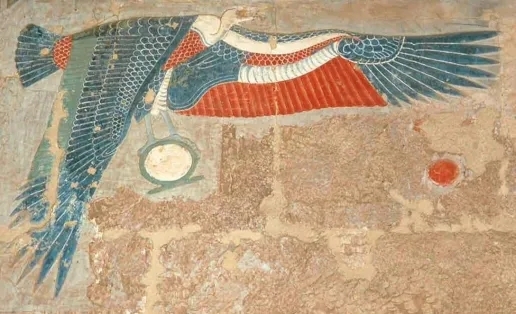 Nekhbet in Her vulture form
Nekhbet in Her vulture formThe vulture hieroglyph is the Egyptian word for mother, mut. So naturally, the Vulture Goddess Nekhbet is associated with mothers, children, and childbirth. This idea persisted so strongly that in the 5th century CE, a Greek writer known as Horapollo noted that when the Egyptians wanted to say “a mother,” they would draw a vulture. He tells us that, since there are no male vultures, when a vulture wishes to conceive, she exposes her vulva to the North Wind for five days…specifically, during the five epagomenal days at the end of (or outside of) the Egyptian year. He tells us that the vulture is a devoted mother, for if she cannot find food for her young, she will tear her own thighs so that the chicks may feed on her blood (not unlike the European legend of the self-sacrificing mother pelican). The Greeks, too, understood Nekhbet’s connection with childbirth for they referred to Her main temple/city, Nekheb, as Eileithyiaspolis. Eileithyia is the Greek Goddess of Childbirth.
Nekhbet is also connected with the number seven (seven Scorpion Wives, seven Hathors). She has Seven Arrows—powerful, sometimes malevolent, forces that the Goddess can turn to good in order to protect the king (and perhaps us, too, if we conjure nicely).
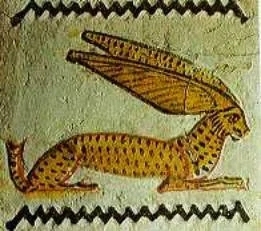 Wenut in Her hare form
Wenut in Her hare formThe Serpent Goddess Wenut’s name means “the Swift One.” So it makes sense to invoke the Swift One to bring about a swift birth. We can certainly imagine the quick strike of a snake leading to such a name. But the serpent isn’t Wenut’s only animal. She is also, even more strongly, connected with the hare. Hares, too, are notably swift, regularly eluding larger, fierce predators. They are also, like rabbits, associated with fecundity. The name Wenut may also be related to a word meaning “to exist,” and so, after death, the Goddess offers ongoing existence and rebirth in the otherworld. Wenut shows up in many of the most well-known funerary texts, such as the Pyramid and Coffin Texts, though not as often as some other Deities. Generally, She is an Upper Egyptian Goddess, Who could sometimes be identified with Nekhbet.
How do our Scorpion Goddesses fit in? First of all, pain and blood; the pain and blood of childbirth. You might recall that the ancient Egyptians conceived of the pain of poisoning as burning. The idea of a burning pain can easily be extended to the pain of birth. (And they weren’t the only ones who conceived of birth pain like this. The Greek Goddess Eileithyia carries burning torches as a symbol of the burning pains of childbirth.) So, it may be that both the Serpent and Scorpion Goddesses are associated with birth pains due to the important ability of these Goddesses to remove such pain.
 Mama scorpion and her scorplings
Mama scorpion and her scorplingsIf you recall some of the scorpion spells from last week, you might remember that the poison is commanded to “flow out” or “flow down;” this would be a very appropriate magical command for birth, too. In the spell above, it is the placenta that is commanded to come down.
What’s more, as a generally protective Goddess, Serket and Her sister Scorpion Goddesses, also protect children. Indeed, it is especially important for children to be so protected, then as now. With their smaller body size, a scorpion sting or snake bite can much more easily kill a child. On the other hand, it may have been the image of the prolific mother scorpion carrying her scorplings (don’t you adore that term?) on her back that so strongly connected the scorpion with birthing and motherhood.
 Taweret, the Great One
Taweret, the Great OneNow, let’s bring in another Divine player Who we have not yet mentioned but Who is part of all this Egyptian birth magic, though not in this particular spell. She is the Goddess Taweret, the Great One. Taweret is the Hippopotamus Goddess of Birth, protectress of mothers and children. As a big-bellied hippo, She is (seemingly) forever pregnant; and hippos, like lions and raptors, were known to be especially fearsome when protecting their young. As She was envisioned in ancient Egypt, Taweret is a composite Goddess, having elements of hippo, lioness, and crocodile. And…yes…the Great One specifically protects against scorpion sting and snakebite, too.
 Iset Djamet, lower right, Serket in the upper center with Her scorpion above Her. There is an iteration of Isis standing right behind Iset Djamet with Her throne above Her head. This is from the astronomical ceiling in Senenmut’s tomb.
Iset Djamet, lower right, Serket in the upper center with Her scorpion above Her. There is an iteration of Isis standing right behind Iset Djamet with Her throne above Her head. This is from the astronomical ceiling in Senenmut’s tomb.If we look to the Egyptian skies at night, we can see Taweret and Serket together. The Great Hippo bears a crocodile on Her back (or sometimes just a croc’s tail), while Her (lioness?) paws drive in a mooring post and subdue a smaller crocodile.
 Here is a slightly different arrangement of the constellations showing the connection between Iset Djamet, the Foreleg, and Serket. This one is from the tomb of Pademenope.
Here is a slightly different arrangement of the constellations showing the connection between Iset Djamet, the Foreleg, and Serket. This one is from the tomb of Pademenope.Sometimes, this constellation is called Reret, Female-Hippopotamus. Sometimes She is Reret Weret, Great Female Hippopotamus. But other times, this constellation is called Iset Djamet (“Isis of Djamet,” which is the ancient Egyptian name for Medinet Habu, where the Ogdoad is supposed to be buried. The Great God Google tells me Djamet means “males and mothers,” presumably referring to the four primordial male/female couples of the Ogdoad). The hippo Iset Djamet is said to hold a golden chain that secures Set’s leg (probably the constellation of the Bull’s Foreleg, Meskhetyu) to a mooring post so that He can’t roam about the skies causing problems for the Deities.
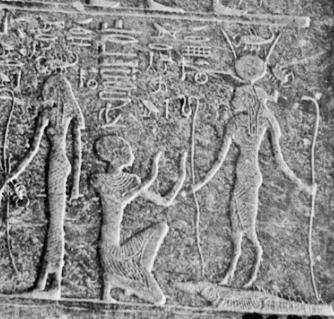 Isis with Taweret legs (?), serpents in hand, and crowned with scorpions on a Cippi of Horus
Isis with Taweret legs (?), serpents in hand, and crowned with scorpions on a Cippi of HorusWe find both the Scorpion Goddess and (perhaps) the Hippopotamus Goddess united in a very interesting and rare image of Our Lady Isis. Here, Isis (specifically labeled as Isis) stands upon a crocodile, with a serpent (or heka serpent wand?) in each hand. Above Her horns-and-disk crown is a scorpion, with another scorpion just behind Her head. But look at Her legs. Some scholars have guessed them as the legs of a deer or gazelle. But Robert Ritner suggests that they are Taweret’s legs. Now, I haven’t found a Taweret with hooves like this yet, but I’m going to bet Ritner has seen more examples of obscure Egyptian art than I have. Though I wonder whether they might be a misinterpretation of Taweret’s lioness legs, with their backward knee bend?
And we have now circled back to Isis, She to Whom this blog is dedicated. Isis is All Things, and All Things are Isis. Isis is the Goddess of Ten Thousand Names. She is the Delta Scorpion Goddess Iset Ta-Wahaet, the Upper Egyptian Scorpion Goddess Iset-Hededyt, and She is Isis-Serket. Since one of Her sacred birds is the vulture, She is easily connected to Nekhbet. And like many Goddesses and Queens, She often wears the vulture headdress. Like Wenut, She is a Serpent Goddess, a fire-spitting Uraeus Goddess—and Her husband is Usir Wennefer, “Osiris the Beautiful Being” or “Osiris Existing in Perfection,” an epithet that shares a root with Wenut’s name. Isis is a Healing and Magician Goddess, powerfully adept at laying down poisons and helping birthing mothers bring their children to the beautiful light of day. As we have just seen, Isis can be understood as one of the identities of Taweret, the Great One of Childbirth. And, of course, Great Isis and Great Hathor have been sharing a connection for millennia. Like all of these Goddesses, from Scorpion Wives to Reret Weret, Isis is the Lady of Protection—on earth, in the heavens, and in the otherworld—as She wraps Her wings around each one of us.
 The Goddess in Her outdoor temple at the Hallows
The Goddess in Her outdoor temple at the Hallows
January 16, 2022
Of Scorpions, Horus & Isis
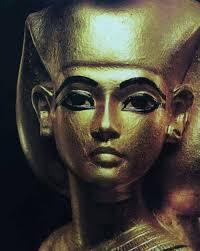 She to Whom One Petitions
She to Whom One PetitionsWe are not yet done with our fierce friends, the Scorpions.
Last time, we learned that Horus, Son of Isis, is married to (at least) seven Scorpion Goddesses. From the little we have left to us of Their myths, it seems They are most often involved with healing poisoning or inflammation. Usually, Their husband Horus is the one They heal…and by extension, the human sufferer, who is identified with Him.
One of the interesting things about the power of these Goddesses is that, frequently, Their blood is involved in the healing. And it is very particular type of blood. It is the blood shed by the virgin Goddess on Her first night taking Horus to Her bed.
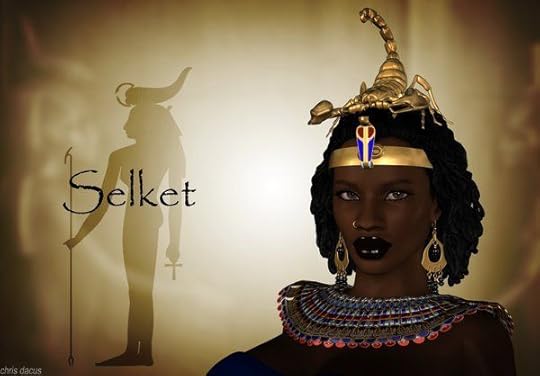 Art by yangzeninja. See more work here.
Art by yangzeninja. See more work here.A quite obscure (as in not-very-understandable) spell in the collection of anti-scorpion-sting spells from the Chester Beatty papyri refers to the blood of (probably) Sepertuenes Who “tells Her name to Horus every three years, the hidden blood being on Her thighs since Horus opened [i.e. had sex with] Her.”
Horus could also be invoked by the blood of another of His most-well-known wives, Ta-Bitchet (alternatively, Tabitchet, Ta-Bitchet, Ta-Bithet, Bithet, and maybe, Biyet):
Hail to You, Horus, by the blood of Tabitchet; Horus opened Her on a bed of ebony. Biyet [Bitchet?], the Lady of the Cobra, a Daughter of Pre! I will recite/enchant against her as a hero. A falcon is to the right, another one to the left of Her. However, I will escape. Horus, hail to You!
Borghouts, spell 97 (my capitalization)
Here, it looks like Horus is invoked by the blood of His wife to help the sufferer repel a cobra bite (?) in a heroic, Horus-like fashion. The venom from both snake and scorpion are often equated, so a Scorpion Goddess is equally adept at drawing out the poison of a snake as She is at commanding a scorpion’s venom to leave the body.
 Ta-bitjet by Doug Morgan. You can purchase the art here.
Ta-bitjet by Doug Morgan. You can purchase the art here.In the next spell in Borghouts, 98, the sufferer invokes Bitchet, the wife of Horus, by the “blood of the first childbirth of the uraeus” and by declaring himself to be Horus. In Spell 99, Bitchet is called a Daughter of Osiris. (So are She and Horus half-siblings?)
Here’s another interesting spell invoking two of Horus’ most well-known Scorpion Wives:
Spell for Enchanting a Scorpion
O Mistress of [. . .], skin-wearer who has come forth from Heliopolis, the Daughter of the Hooded One [or “She of the Nemes Headdress;” possibly equating the hood of a cobra with the Egyptian nemes headdress], without my adding Sepertuenes, She to Whom the Earth Petitions, recite, pray for this young Horus that he might go off recovered to his mother, by the blood of Ta-Bitchet since Horus opened Her in the evening. Seal the mouth of every reptile, O Ta-Bitchet, Shining of Face, Mn.t [which Ritner has as “so-and-so”], O wife of Horus. May Horus live, being healthy/recovered.
Borghouts, spell 101; translations compiled from both Borghouts and Ritner
This one is a bit confusing. But it looks like Tabitchet is invoked by Her own blood to heal the sufferer, who is identified with Horus, Her husband. There is disagreement among the translators where the spell says, “without my adding Sepertuenes.” Above is Ritner’s translation, while Borghouts has it as “I will not leave out Sepertunenes.” Personally, if I were doing this spell, I would add Her, thereby including both of Horus’ powerful wives in this Working to heal a human “Horus.”
There’s also the Egyptian word mn.t, which Ritner translates as “so-and-so.” Does that mean there are a string of common epithets of Tabitchet that we are supposed to know and to add to the spell…similar to how the PGM instructs the magician to “add the usual”?
Now, you may have noticed that the Scorpion Goddesses’ blood is either first-sex-hymen blood or first childbirth blood. This is very powerful and life-giving blood. Another kind of female blood, menstrual blood, had its place in magic, too…and is particularly connected with Our Goddess Isis. See more about that here.
 The Seven Hathors; this piece is broken, but someone has kindly added it back
The Seven Hathors; this piece is broken, but someone has kindly added it backGiven those connections, you will not be entirely surprised to see that the Scorpion Goddesses are also associated with childbirth. And that the seven Scorpion Goddess Wives of Horus may also be connected to the Seven Hathors.
The seven Hathors are generally considered Goddesses of Fate, like the 13 faeries in the Sleeping Beauty tale, Who arrive at a birth to foretell a child’s fate. They are especially found in Late Period temples, where They attend the birth of the Divine Child honored in that particular temple, often but not always, Horus. Like the Scorpion Goddesses, the Seven Hathors are also seven Daughters of Re and are invoked in anti-poison spells—as well as in love spells—as you would expect since They are Hathors. Hathor Herself is also associated with scorpions. On the Metternich Stele, Hathor—identified by the sistrum naos on Her head—is shown subduing frightening handfuls of serpents and scorpions.
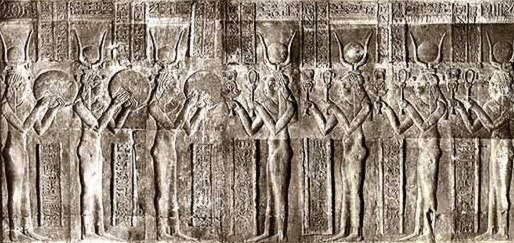 The Seven Hathors playing sistra and hand drums
The Seven Hathors playing sistra and hand drumsProfessor Robert Ritner has suggested that these seven Hathors and the seven Scorpion Wives of Horus—due to Their seven-fold nature and connection with both birth and poisons—may be the same Goddesses, or at least highly-related sets of seven. (On a healing stele, Tabitchet receives the Hathorian epithet “the Golden One.”) Further, Ritner thinks They are connected with the seven maidens in the PGM text of the Charm of the Syrian Woman of Gadara that we looked at last week.
And he also suggests that the seven scorpions that accompany Isis to Chemmis (Panopolis; today Akhmim) may also be the same Goddesses. The Isian scorpions, however, are disguised through use of magical names. As you may remember, in the tale of Isis and the Scorpions, Isis and Her girls are heading to Their refuge in Chemmis. There is another text in which the Scorpion Wives are addressed as “Lady of Chemmis.” So Isis and Her scorpions and the Scorpion Wives of Horus can both be tied to the same place. Ritner has suggested that the names given in the story (Tefen, Befen, Matet, etc.) are magical names of the wives of Horus. He’d need to explain that a bit more to me, but nonetheless, it’s interesting.
 Isis, Horus & the Seven—really big—Scorpions
Isis, Horus & the Seven—really big—ScorpionsMaybe Horus knew these Scorpion Goddesses since His nursery days and then fell in love with Them as He grew. (This would be similar to the Greek Dionysos. His nurses took care of Him while He was a Child God, then accompanied Him as Maenads, though not wives, as an adult.)
There are two interesting Coptic spells, which are much later than the spells we have looked at so far, which involve Horus, Isis, and seven maidens. One seems to be a spell to cure insomnia and the second is definitely an erotic spell. The papyri in which they are found are known as the Schmidt papyri. In them, Horus is complaining to Isis that seven maidens—perhaps a much later version of our Scorpion Goddesses?—are ignoring Him when He so clearly wants them.
Here’s the first one, the insomnia cure, though the translators also wondered whether it was originally an erotic spell:
Hear Horus crying, hear Horus sighing: “I am troubled, poured out/melted for seven maidens, from the third hour of the day until the fourth hour of the night. Not one of them sleeps. Not one of them dozes.
Isis His mother replied to Him within the temple of Habin [near Hermopolis, where a temple and priest of Horus are mentioned as late as the 7th century CE] with Her face turned toward the seven maidens and seven maidens turned toward Her face: “Horus, why are you crying, Horus, why are you sighing?”
“Do you wish that I not cry, do you wish that I not sigh, from the third hour of the day until the fourth hour of the night, while I am poured out/melted for seven maidens, not one of whom sleeps, not one of whom dozes?”
Schmidt 1 papyrus, my capitalization
 Horus weeps
Horus weepsThis spell goes on to give some instructions for sleep and connects it to some angels who made Abimelech (one of several Philistine kings in the Hebrew bible) sleep. That, though, is not the point. The point is Horus sighing and crying over those seven maidens.
The second Schmidt papyrus may refer to the same seven maidens. In it, Horus is complaining to Isis that He “found seven maidens upon a spring of water. I desired, but they did not desire. I agreed, but they did not agree.” Then this Horus-Isis dialog is used to segue into a spell for a love-lorn seeker who says he desired a woman, but she did not desire to receive his kiss.
 Somebody has messed with this, charmingly
Somebody has messed with this, charminglyIn a lecture on this topic, Ritner suggests that while Horus was longing for these seven Scorpion Goddesses, He did the unwise thing and amorously lept on top of Them. They—predictably—stung the crap out of Him. Thus, His need of healing. Yet again.
And so, perhaps, a more ancient story of the yearning-but-stupid Horus evolved into this erotic spell where ‘He desired, but They did not desire.’
Well, we have still not covered everything that these Scorpion Goddesses have to tell us…so, I guess, Part 3 is for next time.
January 9, 2022
The Scorpion Wives of Horus
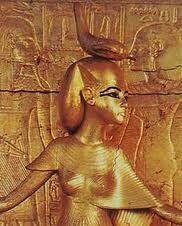 The Goddess Serket guarding one of Tutankhamon’s shrines, along with Her sister Goddesses, Isis, Nephthys, and Neith
The Goddess Serket guarding one of Tutankhamon’s shrines, along with Her sister Goddesses, Isis, Nephthys, and NeithYou already know that Isis is a Scorpion Goddess. She is Iset Ta-Wahaet, “Isis the Scorpion.” And She is linked with Serket, the Egyptian Scorpion Goddess par excellence, as Isis-Serket.
But did you know that Isis’ son Horus also has a thing for scorpions, specifically for Scorpion Goddesses? Well, He does. Indeed, He is apparently married to (at least) seven of Them. Just like those seven scorpions that accompany Isis when She is fleeing from Set after baby Horus’ birth. Hmmm…do scorpions run in this family?
 A Horus king: King Scorpion (with label)
A Horus king: King Scorpion (with label)But let’s back up a minute. How do we know about Horus and the Scorpion Goddesses? It’s not part of the Egyptian mythology we’re familiar with. And that’s true; it isn’t. But then we have so few of the ancient Egyptian myths. And much of what we do have is so confusing and obscure (I’m looking at you, Delta Mythological Manual) that we can hardly make a coherent story out of it. That just wasn’t the way the Egyptians did things. Very often, the only way we know about a myth is from the fragments of it hidden in other texts…particularly in magical texts that include what is known as a historiola, a little bit of a myth that relates to the subject of the spell.
 Horus often needs some help
Horus often needs some helpOur boy Horus is often the subject of these historiolas, particularly when the spells invoke the aid of Isis as healer. Just as Isis comes to the aid of Horus in the story, so She will come to the aid of the present-day sufferer, who is identified with Horus. There are a whole series of these types of spells that are intended to cure inflammation, which can include anything from the pain of swollen breasts in a new mother to the fiery pain of poison from a snake bite or scorpion sting, which the Egyptians described as “burning.” As a whole, these spells are sometimes referred to as “burning Horus” spells since Horus is so often in fiery pain for one reason or another—and requires healing.
There’s an interesting example of this from the Greco-Egyptian magical papyri, aka the PGM.
The Charm of the Syrian Woman of Gadara for Any Inflammation
The most majestic Goddess’ [Isis] child [Horus] was set aflame as an initiate—and on the highest mountain peak was set aflame. And the fire did greedily gulp seven springs, [seven] of wolves, seven of bears, seven of lions, but seven dark[-blue] eyed maidens with dark[-blue] urns drew water and becalmed the restless fire.
PGM XX
Horus is almost always on a mountain or in the desert when He gets burned. In this case, His burning is an initiation, which recalls Plutarch’s version of the Isis-Osiris story where Isis nurses the child of Queen Astarte and burns away the mortal parts of his body at night, thereby initiating him into immortality.
In another example, Isis is speaking to a feminine person and tells her to get water to relieve Horus in Isis’ own absence:
My son Horus is burnt upon the gebel (mountain). There is no water there. I am not there. May you (fem.) bring water from the banks of the stream to extinguish the fire. Recitation over milk of a woman who has borne a male child.
Papyrus Ebers
Here, milk is blessed and charged by speaking this spell and then used to soothe the burn. Learn more about Isis and milk here.
 One of Horus’ Scorpion Goddess wives? Art is by Lorenn Tyr. See more of their art here.
One of Horus’ Scorpion Goddess wives? Art is by Lorenn Tyr. See more of their art here.It is in these types of healing spells that we meet the Scorpion Goddess wives of Horus. Traces of Them have been found in papyri, on ostraca, in graffiti, and on healing statues dating from the 14th century BCE to the end of dynastic Egypt. There may even be an older allusion to Them in the Coffin Texts, where Horus is said to “belong to the Great Lady of the Desert, the Lady of Flame … Who bites with Her mouth, Who strikes with Her tail” (my capitalization). So these Goddesses were quite well known and remained so.
In one of the spells in the Turin papyrus, the Goddesses are said to be Daughters of Re and They bring drink and magical knots to heal Horus during one of His mishaps. In one of the papyri collected by American mining magnate Chester Beatty, we find a long-ish spell against scorpion stings. In the spell, the scorpion’s poison is called to flow out of the person. The poison is called forth seven times—in the names and by the power of each the seven wives of Horus. As Scorpion Goddesses Themselves, They are capable of calling the poison out of the sufferer. In this particular spell, instead of being the victim of poisoning, Horus “the Physician” is working with His wives to draw out and remove the poison.
 Horus with the 7 scorpions; drawn from a healing statue of Djed-Hor
Horus with the 7 scorpions; drawn from a healing statue of Djed-HorThis spell includes a few of the names of the Goddesses. It is quite damaged, so we can’t see all Their names, though from the structure of the spell, we know seven were originally listed. Yet a list of all seven can be reconstructed from a variety of sources. There are two that are the most well known, appearing in a number of other surviving spells. They are Sepertuenes, “She to Whom One Petitions,” and Ta-Bitchet, which combines the Egyptian feminine article ta with a Canaanite or Amorite word and may mean “The Daughter.”
 Isis, Horus & the 7 scorpions; drawn from the Metternich Stele that includes the story of Isis & the 7 Scorpions
Isis, Horus & the 7 scorpions; drawn from the Metternich Stele that includes the story of Isis & the 7 ScorpionsOther Scorpion Goddesses identified as wives of Horus include Ifdet, “She Who Runs,” Wepetsepu, “She Who Judges Misdeeds,” and Sefedsepu, “She Who Slaughters Misdeeds (or misdeed doers?).” And finally, Metemet-nefertiyes, (the first part of Her name is not translatable, then…) “Beautiful When She Comes,” and Batcheh. Batcheh is not translated but She defines Herself in another text as “the uraeus Who bore the Gods.”
In another of the Chester Beatty papyri, we learn of another Goddess Who may also be a wife of Horus. She is Sefet-Sefekh, “Seven Slayers,” Who recites a spell for the sufferer as She did for Horus when He was poisoned. (Or it may be that ‘Seven Slayers’ is an amalgamation of all seven wives.) In still another, we have a wife of Horus named Tamenet…though I wonder if that name might be a corruption or shortening of the first part of Metemet-nefertiyes’ name. And there may be others listed in other spells, but this is uncertain due to the deteriorated state of the texts.
 A classic Goddess Serket; note the stars on each of the scorpion’s claws
A classic Goddess Serket; note the stars on each of the scorpion’s clawsSome scholars think that all these Scorpion Goddesses may be manifestations of the one Great Scorpion Goddess, Serket. In one spell against poisoning, Wepetsepu specifically calls Herself not only by Her own name, but also says She is Serket. Serket is named as a consort of both Horus the Younger and Horus the Elder. In some tales, Serket is the mother of the four Sons of Horus; in others stories, Isis is the mother of the four Sons of Horus (the Elder). And of course, Isis and Serket can be connected as Isis-Serket.
In a spell invoking Sepertuenes, the scorpion who stung the sufferer is addressed with reference to “your mother Isis.” So the scorpion is a daughter (apparently all scorpions are daughters) of Isis the Scorpion Goddess. In addition to Isis’ identification as Iset Ta-Wahaet, we discover another Scorpion Isis. This one is Iset Hededyt, a name that relates to the concepts of whiteness and luminosity.
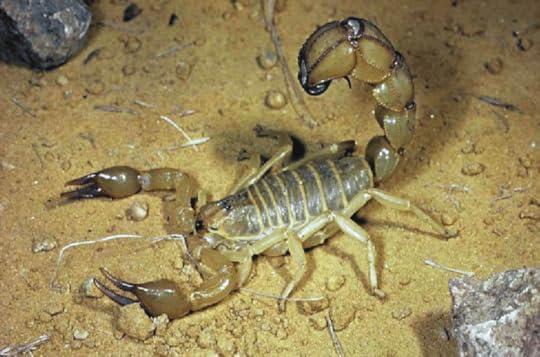 Hededyt, the very dangerous, light-colored scorpion
Hededyt, the very dangerous, light-colored scorpionIt seems that the Egyptians classified scorpions by color, either light or dark. So as Isis Hededyt, She is associated with the lighter-colored types. One scholar I’m reading thinks that Hededyt may be able to be identified as the androctonus australis scorpion, loosely meaning “southern man-killer.” As you might guess, this desert-dweller is quite poisonous, indeed it is one of the world’s most dangerous. Hededyt is called a Daughter of Re, just like the scorpion wives of Horus, and She protects Re as He journeys in the solar barque. In later periods, She protects Osiris and Horus and becomes—forevermore—Iset Hededyt. Iset Hededyt seems to be more associated with Isis’ Upper Egyptian forms, while Iset Ta-Wahaet is associated with Lower Egypt.
There’s more to say about Horus and His Scorpion Goddess wives and how Robert Ritner*, Professor of Egyptology at the Oriental Institute and author of The Mechanics of Ancient Egyptian Magical Practice, thinks they may tie in with the PGM spell we started with. But this post is long enough for now. We’ll do Part 2 next time.
*Sadly, Professor Ritner died last year. He and his excellent work will be missed.
December 31, 2021
DO Look Up…and see Her
This is a slightly revised repost, dear Isiacs…and a little earlier than my usual Sunday posts. But don’t bounce. There’s a secret here that all who love our Goddess should know. I am posting this because an amazing stellar event happens worldwide on our modern New Year’s Eve—and I want you to be a part of it. You see, SHE is visible throughout the world in a striking way at the New Year. So, for those of us who see Isis in the light of Her beautiful star, every New Year’s Eve is special…
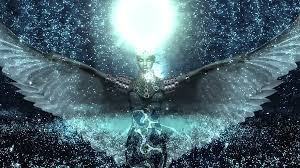 Isis as Sirius by Sirius Ugo Art
Isis as Sirius by Sirius Ugo ArtWhy?
Because the Star of Isis reaches its highest point in the night sky at midnight on New Year’s Eve. In the Northern Hemisphere, look toward the south, and you’ll easily see Sirius shining there around midnight. In the Southern Hemisphere, look overhead or high to the north at around midnight. She will be there. Glittering and gleaming in the depths of the night sky…
This means that the Star of Isis can be our New Year’s Star just as the heliacal rising of Sirius was the Star of the New Year for the ancient Egyptians. I find this fact to be a small miracle, a gift of the Goddess that we can unwrap every New Year’s Eve. (For some Sirius science, look here.)
While some may see Isis in the pale, magical light of the moon. And others may see Her in the golden, life-giving rays of the sun. (I do find Her in both those places; oh yes, yes, yes.) But for me, the heavenly body in which I most easily see Her is the star, Her star: Sirius (Sopdet in Egyptian, Sothis in Greek).
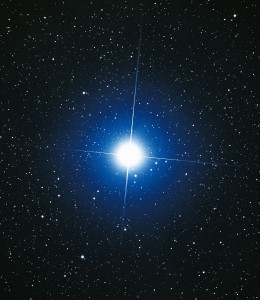 The Star of Isis is at its highest point in the night sky right now
The Star of Isis is at its highest point in the night sky right nowI can’t help it. And it isn’t just because of Her strong ancient connections with the Fair Star of the Waters, the Herald of the Inundation. It’s something about the way my particular spiritual “stuff” fits with Her particular Divine “stuff.” Her diamond starlight draws me, lures me, illuminates my heart and mind.
I fell in love with Her as Lady of the Star the first time I saw Sirius through a telescope (thank you, Alana and John). As I watched, Her brilliant star sparkled with rays of green and blue and pink and white. It was incredibly, unutterably beautiful. It was alive. And pure. And holy.
You may already know why Sirius was important to the ancient Egyptians, so I won’t repeat that here. But I would like to add a few interesting bits about Sirius that you may not know; in particular, the orientation of some Egyptian temples and shrines to Sirius at the time of their construction. For instance, the small Isis temple at Denderah and Isis’ great temple at Philae seem to have been oriented toward the rising of Sirius. Philae may even have a double stellar orientation: one axis to the rising of Sirius, one to the setting of Canopus.
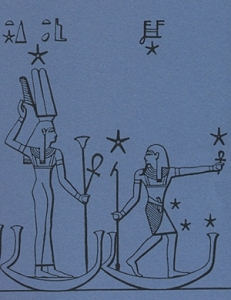 Iset-Sopdet following Sah-Osiris in Their celestial boats
Iset-Sopdet following Sah-Osiris in Their celestial boatsOverall, Egyptian temples have a variety of orientations. A survey team in 2004 to 2008 actually went to all the temples in Egypt and measured their orientations. They showed that most temples were oriented so that the main doorway faced the Nile. But not only that. It seems that the temples were also oriented toward other astronomical events, most especially the winter solstice sunrise, which makes very good sense as a symbol of rebirth.
Orientation to Sirius is rarer and harder to be certain of since the earth’s position in relation to the stars has shifted over the millennia.
A Horus temple, called the “Nest of Horus” on the summit of the highest peak of the Hills of Thebes, seems to have been oriented to the heliacal rising of Sirius around 3000-2000 BCE. Nearby, an inscription carved in rock during the 17th dynasty records the observation of just such a rising of Sirius. This high place would have been ideal for Horus in His nest to await the coming of His mother Isis. On the other hand, the archaeo-astronomers who did the survey I mentioned believe that it may also be oriented to the winter solstice sunrise, an event closely associated with Horus.
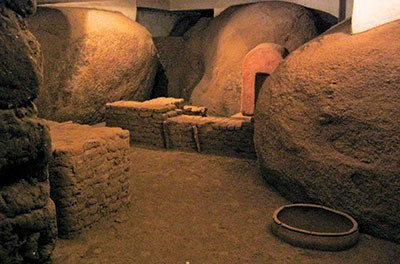 The ancient Temple of Satet at Elephantine, nestled amid the boulders
The ancient Temple of Satet at Elephantine, nestled amid the bouldersAnother temple that may have a Sirius orientation is the archaic temple of the Goddess Satet on the island of Elephantine. The original temple was built amidst the great boulders on the island and really is quite simply the coolest temple ever. It seems that when it was built (around 3200 BCE) the rising of Sirius and the rising of the winter solstice sun were at the same place—so it could have been built to accommodate both important astronomical events.
After the initial study, the same team followed up with a survey (in 2008) of some temples in the Fayum that they hadn’t been able to study before as well as temples in Kush. They found generally the same results except for the Nile orientation as many of these temples were built far away from the river. They made note of a son of a Priest of Isis, Wayekiye, son of Hornakhtyotef, who was “hont-priest of Sothis (Sopdet) and wab-priest of the five living stars” (the planets) and “chief magician of the King of Kush;” this according to an inscription on Isis’ temple at Philae dating to about 227 CE. This emphasizes the importance and sacrality of the study of celestial objects and events to the kingdom and it is quite interesting that this was the work of the Chief Magician. This 2008 study revealed that the largest number of Kushite temples and pyramids were oriented to either the winter solstice sunrise or the rise of Sirius.
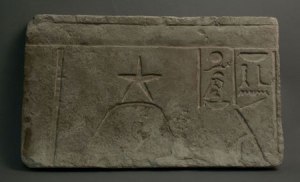 The star Sopdet over the head of the Goddess
The star Sopdet over the head of the GoddessAnother interesting thing the study found was that by the time of the New Kingdom, in the 34 temples that were unmistakably dedicated to a Goddess—specifically Isis or a Goddess identified with Her—the most important celestial orientation point was the rising of Sirius. But, in addition to Sirius, the star Canopus was also a key orientation point. According to their data, Goddess temples in general were more frequently aligned with these very bright stars, Sirius and Canopus, while God temples were more often oriented to key solar-cycle events.
The New Year has always been a time of reorientation and renewal, of oracles, portents, and purifications. As Sopdet, the Ba or Soul of Isis, shines down on us from its highest vantage point, now is a perfect time to undertake our own personal rites of renewal and reorientation. It is a time of clarity as we bathe in Her pure starlight, a time when we may ask for Her guidance.
Whatever your favorite divination method, why not do a reading for the New Year while She rides high in the sky?
Or, if you like a more ritualized oracle, try “The Rite of Loosing the Eyes” in Isis Magic. It is a winter rite in which you purify yourself and your temple, then ask Isis and Nephthys as the Eye Goddesses Who Go Forth to bring you news of what the New Year has in store. And May They bring us good news for 2022 after the years we have all been through.
Amma, Iset. Grant that it be so, Isis.

From the Northern Hemisphere, look toward the south, and you’ll easily see Sirius shining there at around midnight. From the Southern Hemisphere, look overhead or high to the north at around midnight.
December 26, 2021
A Vision of Nephthys
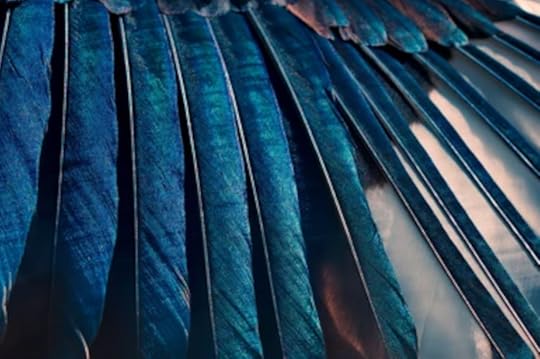 Iridescent wings, dark and gleaming
Iridescent wings, dark and gleamingAs always…this is my visionary experience; your vision may (and will) vary…
When She comes, She arrives in a splendor of iridescent wings, dark and gleaming like mother-of-pearl, like a raven oil-slick. Long, black hair and dark eyes of fiery orange-gold. Her hands are twisting and weaving threads of heka, magic. “These are the relationships,” She says. “You must continue to weave them if you would live a happy life.”
“Have I not been?” I ask. “You forget, sometimes,” She says.
 Wise of Counsel
Wise of CounselHer clothing is dark with stripes; the Limits that are Hers. She speaks softly, but with such kind firmness that one cannot help but listen and hear.
“Will you tell me Who You are?” I ask, meaning will She tell me about Her nature, Her powers. She indulges me with a wry look. “I am Peace. I am Solidity. I am She Who Establishes. I am the Formula, the Plan that underlies” [underlies both magic and festival rites, I intuit as She speaks].”
Of course, I say to myself. She is the One with Reasonable Plans and She is called Great of Plans. She IS the Plan. “I have helped you times before,” She says in continuation of my thought. “So…do I have this ritual right?” I ask, meaning the contact ritual I shared with you last week and which I have used to have this vision. “Mostly,” She says. “It will come.” And, of course, I knew that; both that it was not quite-quite right yet and that it will come.
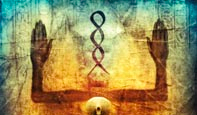 Heka: to strike the ka
Heka: to strike the ka“Will You tell me of Your heka?” I ask Her. She answers enigmatically, “I am the One Who is suspended; my magic is arrow-swift, yet I hover as a hummingbird.” Since I am not exactly sure what She means by this, I ask again. “The strength of My magic is held in suspense. It gathers until released.”
How does one do that? I wonder. And can I do that? “Yes,” She affirms. She is teaching me a magical technique, then…a visualization to use: “Levitation on breath,” She says. “Bones light as birds’ bones; invisible wings fanning fast. Suspend yourself by the heart between the Pillars. [She means my Hermetic/Qabalistic Pillars; since it is a paradigm I have in my head, She uses it.] “Feel Our wings beating; see slowly, but know it as speed. Gather it at the heart. When ready to ‘push the ka,’ send it out swift.”
 This is probably Nuet, but I can’t find the artist. Anyone know? Nevertheless, there’s something here that catches a bit of the vision.
This is probably Nuet, but I can’t find the artist. Anyone know? Nevertheless, there’s something here that catches a bit of the vision.I believe She is teaching me bird-magic as a way of using heka. The hovering, the lightness requires the magician to reach a certain state of consciousness within themselves. The beating of the wings is the gathering of heka; you envision it, “see” it, in slow motion, but know that its true rhythm is not slow at all. When ready, it is released quickly, like a hawk striking. (“Striking the ka” is one possible meaning for he-ka according to some Egyptologists I’ve been reading. (Yes, exactly; the stuff in my head also feeds into the vision.)
Personally, I have often envisioned magic/heka as a well-timed ‘push.’ She says to pay attention to the birds. Because their bones are light, they feel the vibration of heka easily. (She is a Bird Goddess.)
I ask about heka on a larger scale; to affect circumstances, for instance. Nephthys, Wise of Counsel, wisely counsels to Work with the Deities. “In relationship with Them, with offerings to Their kas, They may choose to assist you by allowing you to/helping you to push or strike Their kas.”
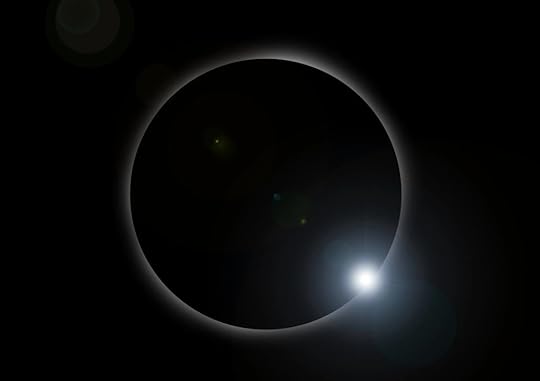 “Why do you cast a magic circle?”
“Why do you cast a magic circle?”“Will you tell me about Your epithet, “Who Predicts Events”? I ask. “It is from Upper Egypt and relates to My Being as the Iret Eye. I send out Myself as Iret to see Tomorrow and Yesterday. It is done at the Akhet,” She says. I ask if She will tell me about Her temple and its limits. “Why do you create a magic circle?” She says. “Once created, the liminality of the circle opens to all realms of possibility.”
I am tired with the effort of vision now. Although I have not spoken, She knows and answers, “I have all patience.”
I thank Her, kiss the ground before Her beautiful face and close the ritual. As I acknowledge the Horizons, the temple of the Lady of the Temple dissolves into Light. All boundaries are crossed. All time-and-space exists forever.
 All boundaries dissolve into Light
All boundaries dissolve into Light
December 19, 2021
Establishing the Temple of Nephthys
Alright. I have the ritual. But it is a bit raw. That is where I am with Her. In a new, raw place. (Those of you who are already devotees of this Great One are smiling indulgently. And that’s okay.) And so, I shall share this with you in its raw state. She might prefer it that way; I kinda get that from Her. But She’ll let me know. Of that, I am sure.
 Temple at eternal twilight
Temple at eternal twilightNext time, I’ll write up the vision I had with Her, since this post will be quite long enough as it is. Maybe you’ll have your own vision by then…
Establishing the Temple of Nephthys
Entering
Move to the West of the ritual space. Stand with your hands palm-to-palm at your heart. Breathe in. Make the Nebet gesture by crossing your hands, one over the other, at your heart, then slowly and gracefully opening your arms in a wide arc, palms up. Imagine you are cradling a very large, wide, and shallow vessel, the “nebet” vessel.
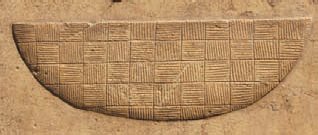 Nebet gesture: imagine you are cradling a huge bowl or basket; this is the bowl on the top of Nephthys’ name glyph
Nebet gesture: imagine you are cradling a huge bowl or basket; this is the bowl on the top of Nephthys’ name glyphDevotee: Come to me, come to me, Nephthys, Goddess, Lady of the Temple. Come to me and let me come to You.
Purification & Consecration
Prepare your purification and consecration vessels. Pure water in the Cup; light charcoal and prepare incense for Censer. Take up the Cup and elevate it as you call the Souls of Night into it.
Devotee: O You Souls of Night, Water Dwellers, Purifiers, You of the Pure Water from the Well of Nephthys, I have come for You! By the Depth, by the Strength, by the Magic of Nephthys, establish Yourselves within this vessel. (Vibrating into Cup) NEBET-HWT MU! (Neh-bet-Huut moo)
Walk clockwise around the ritual space, sprinkling with water and speaking the following words:
Devotee: Nephthys is pure, the temple is pure. The temple is pure, I am pure. I am pure with the purity of Nephthys. I am pure with the purity of the Goddess.
Upon your return to the West, purify yourself, then elevate the Cup and say:
Devotee: By the Magic of Nephthys, it is so!
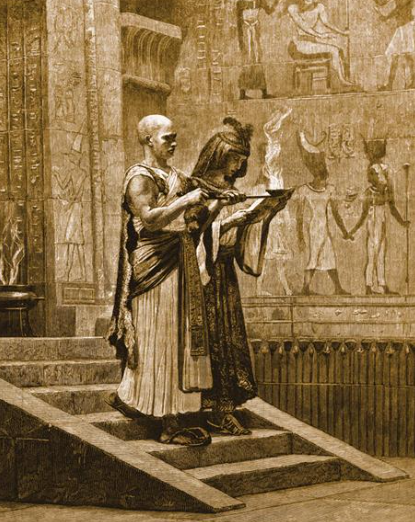 Purifying & consecrating
Purifying & consecratingReplace the Cup and take up the Censer. Elevate the Censer as you call the Souls of Day into it.
Devotee: O You Souls of Day, Fire Dwellers, Consecrators, You of the Pure Flame from the mouth of Nephthys, I have come for You! By the Depth, by the Strength, by the Magic of Nephthys, establish Yourselves within this censer. (Vibrating into Censer) NEBET-HWT ASH! (Neh-bet-Hutt aash)
Walk clockwise around the ritual space, censing with incense and speaking the following words:
Devotee: Nephthys is consecrated, the temple is consecrated. The temple is consecrated, I am consecrated. I am consecrated with the fire of Nephthys. I am consecrated with the flame of the Goddess.
Upon your return to the West, cense yourself, then elevate the Censer and say:
Devotee: By the Magic of Nephthys, it is so!
Establishing the Horizons
Move to the center of the ritual space. Prepare yourself. Then move to the East of the ritual space. Raise your hands in the Akhet gesture, first holding it close to your heart, then as you speak the words, extending the sign, with strength, towards the East.
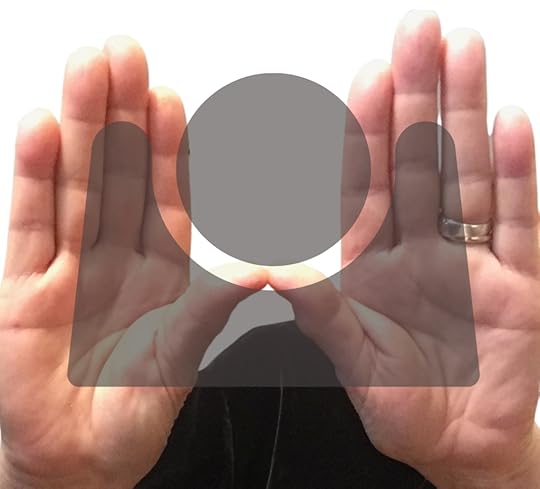 The Akhet gesture
The Akhet gestureDevotee: In the name of the Lady of the Limit, the Eastern Horizon is established!
Turn around and move directly to the West. Repeat the Akhet gesture.
Devotee: In the name of the Lady of the Limit, the Western Horizon is established!
Circle clockwise from West to South (passing North and East). Raise your hands in the Akhet gesture, first holding it close to your heart, then as you speak the words, extending the sign, with strength, towards the South.
Devotee: In the name of the Lady of the Limit, the Southern Horizon is established!
Turn around and move directly to the North. Repeat the Akhet gesture.
Devotee: In the name of the Lady of the Limit, the Northern Horizon is established!
Circle clockwise around the space until you return to the West, facing East.
Establishing the Boundaries of the Temple
Take up your magic wand and trace a small rectangle on the floor in the West; this is the Gateway.
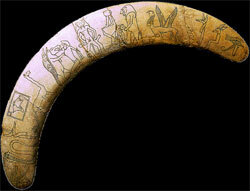 An Egyptian magic wand; yours could look like this one or something else
An Egyptian magic wand; yours could look like this one or something elseBeginning at the left side of the Gateway, walk around the ritual space, clockwise, tracing a large circle around the entire space. Trace this circle inside the established Horizons while you are walking outside the circle as you trace it. Connect the circle to the right side of the Gateway.
Standing in the Gateway, pause. Take a moment to visualize the Horizons, the Gateway, and the Circle you have traced. Breathe in, and with purpose and forethought, breathe out as you step through the Gateway saying:
Devotee: Let me enter Your temple, O Great Goddess Nephthys.
When you have entered, envision the Gateway closing and the ritual circle becoming whole. Place your magic wand on the floor, across the Gateway.
Knowing the Horizons
Move to the center of the ritual space, facing East. Place your hands, one over the other, at your heart.
Devotee: At the Eastern Horizon, the twilight dawning exists forever. The Brilliant One ever arises in perfection (bowing toward the East in acknowledgement).
Turn to the South.
Devotee: At the Southern Horizon, the day exists forever. The Barque of the Day navigates the skies in beauty always, always (bowing toward the South in acknowledgement).
Turn to the West.
Devotee: At the Western Horizon, the twilight dusk exists forever. The Brilliant One ever sets and begins to dream in perfection (bowing toward the West in acknowledgement).
Turn to the North.
Devotee: At the Northern Horizon, the night exists forever. The Barque of the Night journeys through the Otherworld always, always (bowing toward the North in acknowledgement).
Invoking Nephthys
Turn to the East. Make the Nebet gesture, slowly and with intention.
 Nephthys by Jeszika Le Vye; you can purchase a copy here.
Nephthys by Jeszika Le Vye; you can purchase a copy here.Devotee: (Invoking) Beautiful Sister, Nephthys, I open myself to You.
I call to You from my heart. With my tongue, I speak Your name. In my mind, I see Your wings. In my body, I feel Your flames, O Senet Noferet, Good Sister, Kindly and Wise of Counsel.
I call out to Your Truth, Your Ma’et! Reveal to me what You will of Your Deep Mystery. Come to me, Sister of my heart and soul, Sister Who protects my ka and my ba and my akh, forever and ever.
Come to Your House, O come to Your House, Lady of the Limit! Open Your temple to me for I am one who loves Your Sister and in Her name, I ask entry into Your House. Lady of the Liminal, let me enter into the Akhet, the Shining Place. Let me shine, too, in the reflection of Your grace, Your light, Your wings.
I open my heart, I open my mind, I open mySelf unto Nephthys, only Nephthys. Come, Goddess! Come with Your Ka and Your Ba and Your Akh! Come to Your temple, O Lady! Descend on gleaming wings—and come to Your temple. Rise in the Barque of the Night—and come to Your temple. Expand within my heart—and come to Your temple, my Beautiful Sister.
Place your hands, palm-to-palm, at your heart. Breathe in and visualize the Light of the Goddess flowing from above into your head and down through the center of your body into the space beneath your feet. Breathe out and feel Her Light pooling beneath your feet. Breathe in and draw Her Light up into your heart. Vibrate Her name, opening your hands—slowly and with intention—so that Her Light flows out into the temple space.
Devotee: (Vibrating) NEPHTHYS! (Alternately, you can vibrate Nebet-Hwt for Egyptian or Nebtho/Nephtho for Coptic Egyptian.)
Do this twice more.
Envisioning Nephthys
Be seated comfortably in meditation on the presence of the Goddess. You may simply sense Her presence around you or you may have a full vision of Her and conversation with Her. Let this develop as it does naturally.
When you are complete with your experience, stand, make the Nebet gesture, and thank the Goddess for Her presence.
Devotee: The Lady of the Temple is within Her temple. Blessed is the Lady.
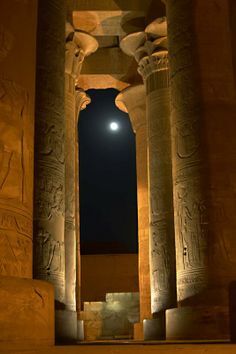 Temple by full moonlight
Temple by full moonlightOpening the Boundaries of the Temple
Circle clockwise to the West and take up your wand from the Gateway. Walking counterclockwise and this time on the inside of the circle, un-trace the circle that you originally traced with the wand. When you reach the Gateway, face East, and take one step back through the Gateway. Now see only the Horizons before you and be aware of the West behind you. Sweep away the Gateway as the priests swept away their footprints after the Daily Ritual.
Return to the center of the ritual space. Face East.
Devotee: (With hands crossed over heart) The Eastern Horizon endures forever (bowing slightly).
Turn to the South.
Devotee: (With hands crossed over heart) The Southern Horizon endures forever (bowing slightly).
Turn to the West.
Devotee: (With hands crossed over heart) The Western Horizon endures forever (bowing slightly).
Turn to the North.
Devotee: (With hands crossed over heart) The Northern Horizon endures forever (bowing slightly).
The Temple Returns to the Akhet
Visualize the entire scene before you illuminated in incandescent Light. Everything is obliterated in the Divine Light. Everything exists forever, everything returns to the Shining Akhet, forever and ever.
When you are ready, quit the ritual space.
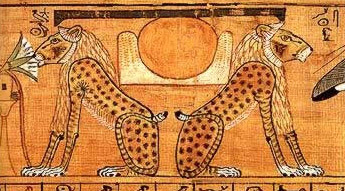 The Akhet glyph between the Ruti, the lions of Yesterday and Today
The Akhet glyph between the Ruti, the lions of Yesterday and Today



